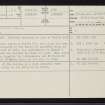Pricing Change
New pricing for orders of material from this site will come into place shortly. Charges for supply of digital images, digitisation on demand, prints and licensing will be altered.
Aberdeen Castle
Castle (Medieval), Motte (Medieval)(Possible)
Site Name Aberdeen Castle
Classification Castle (Medieval), Motte (Medieval)(Possible)
Alternative Name(s) Castlehill; Aberdeen, Castle Hill, Barracks
Canmore ID 20130
Site Number NJ90NW 22
NGR NJ 9460 0640
Datum OSGB36 - NGR
Permalink http://canmore.org.uk/site/20130
- Council Aberdeen, City Of
- Parish Aberdeen
- Former Region Grampian
- Former District City Of Aberdeen
- Former County Aberdeenshire
NJ90NW 22 9460 0640
See also NJ90NW 786.
(NJ 9560 0640) Infantry Barracks on site of Castle (NR)
OS 1:500 Aberdeenshire, 2nd ed., (1901).
The barracks stand on Castle Hill occupying the area within the ramparts of the Castle of Aberdeen which is first mentioned in 1264, was surrendered to Edward 1 after 1285 and was retaken by Bruce in 1308. Many years later it was razed by the townspeople and St Ninian's Chapel (NJ90NW 38) was built on its site c.1500.
Name Book 1866; G M Fraser 1905.
The site of the castle, on a high eminence over-looking the city, is now occupied by flats.
Visited by OS (JLD) 20 August 1952.
Suggested as motte.
P A Yeoman 1988.
(Additional references cited).
NMRS, MS/712/83.
Air photograph, Cromwell's bastion and site of the castle: AAS/00/08/CT.
NMRS, MS/712/100.
Nothing is visible of either the motte or the later castle of Aberdeen, which lie in a built-up part of the city.
Visited by RCAHMS (JRS, ATW), 26 February 1997.
NMRS REFERENCE:
Aberdeen, Castle Hill, Castlehill Barracks.
Probably 18th Century, 1794-6.
Plans: See G.M.Fraser's "Historical Aberdeen" pp.74-75
" " " Archibald Simpson, architect and his times. 1908.
Online Gallery (1306 - 1329)
The year 2014 sees the 700th anniversary of the Battle of Bannockburn, in which the army of Robert I of Scotland defeated that of Edward II of England. The battle marked a major turning point in the long, drawn-out struggle of the Wars of Independence.
The Wars have had a lasting influence upon all the nations of the United Kingdom and upon the national story. Each age has seen fit to commemorate the events in its own way: through the perpetuation of the genuine historical associations of buildings and places and also through the endowment of others with improbable or fanciful traditions. Where past generations allowed its historic buildings to decay and disappear, later generations began to value and actively preserve these for their associations. Where an event lacked a tangible reminder, as at Kinghorn where Alexander III was killed in a riding accident, a commemorative monument would be erected to act as a focus. The Wars of Independence predate the fashion for accurate portraiture: the weathered, generic military effigy of Sir James Douglas is one of the few to survive in Scotland. Later centuries saw a need and supplied it by a crowd of images of its historic heroes, William Wallace and Robert the Bruce, each depicted according to contemporary taste and imagination. The opening of the new heritage centre at Bannockburn takes this into a new dimension, through the use of three-dimensional, digital technology.
RCAHMS Collections hold many images of these buildings and locations from battlefields, castles and churches, to the many commemorative monuments erected in later years. This gallery highlights a selection of these, including antiquarian sketches, photographic and drawn surveys, and architectural designs.
Publication Account (1997)
A castle was in existence in Aberdeen by 1264 at latest. The Exchequer Rolls for this year detail expenses incurred in its provisioning. Payment was also made for building work on the castle, although this was probably of the nature of repair or extension rather than the commencement of the construction of the castle since it already by this date housed a chapel. It is presumed that the fortification was placed on the later-named Castle Hill, although the primary source material does not state its exact site. It is possible that some form of castle had existed in Aberdeen from the first founding of the burgh, although Castle Hill was no more favoured a situation than St Katherine's Hill since neither offered a ready water supply. A highly speculative theory is that an earlier castle or fortification had been positioned on St Katherine's Hill. If this was indeed the case, the clustering of the first dwellings at the base of St Katherine's Hill, rather than Castle Hill, for protection, could partially explain the early development of the town in this area, rather than at the eastern end of Castlegate. Sometime during the early fourteenth century the castle appears to have been destroyed, most probably during the Wars of Independence. Lack of water would make the Castle Hill highly susceptible to successful siege. It was still standing in July 1308, however, after the supposed occasion of the razing of the castle to the ground by the burgesses of Aberdeen with their rallying cry of 'Bon Accord'. On 10 July Edward II instructed his admiral William le Betour to gather reinforcements from Hartlepool, Newcastle, Berwick on Tweed and other strongholds to assist in raising the siege of Aberdeen Castle. 3 Documentary evidence for the castle after this event has so far not come to light. The office of warden, however, remained hereditary in the family of Kennedy of Carmuc, who retained the title of Constable of Aberdeen until the end of the sixteenth century.
Archaeological investigations have so far produced no direct evidence of the castle, though excavations in Virginia Street and to the south of Castlegate (see area 9 & 11) have produced evidence of medieval deposits in its probable vicinity.
Information from ‘Historic Aberdeen: The Archaeological Implications of Development’ (1997).








